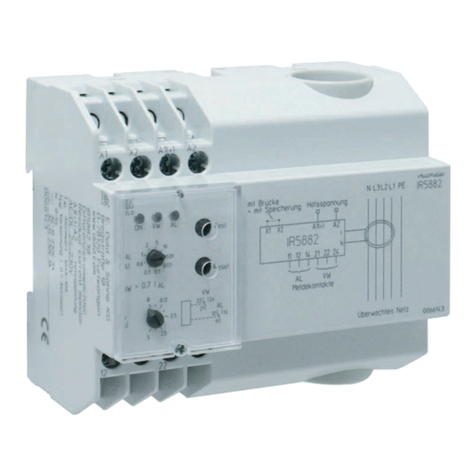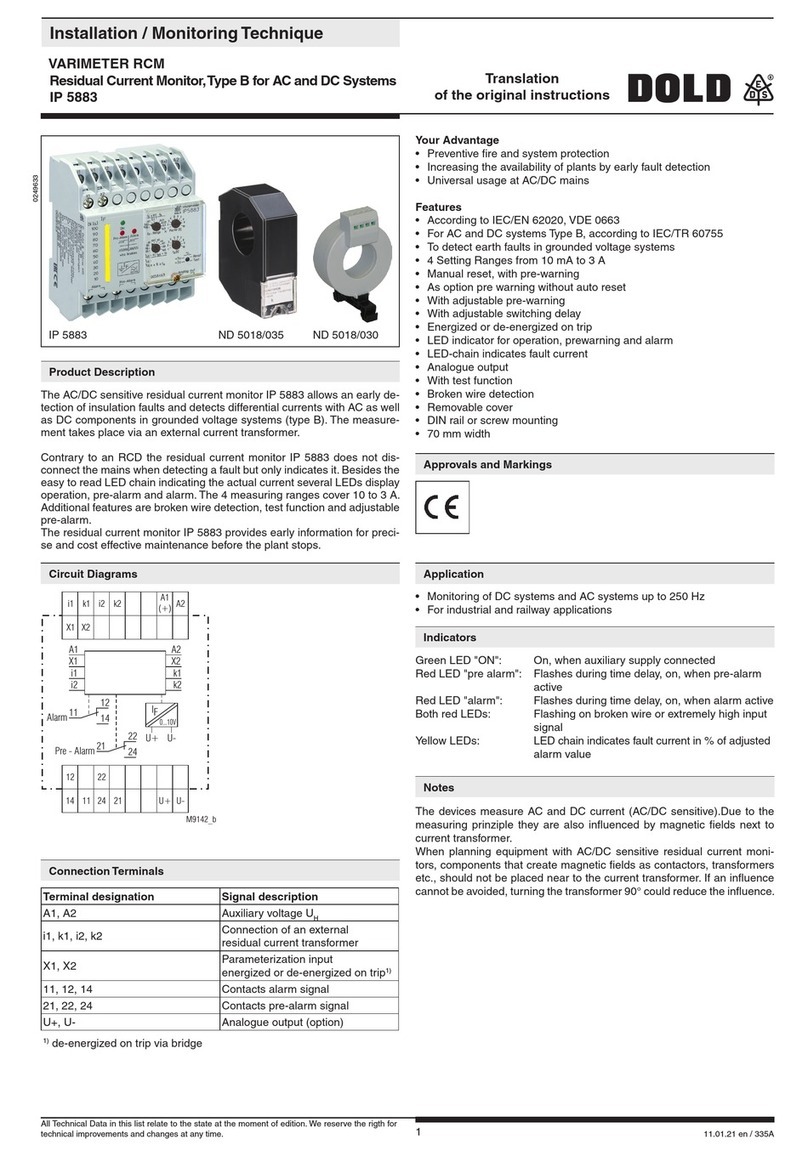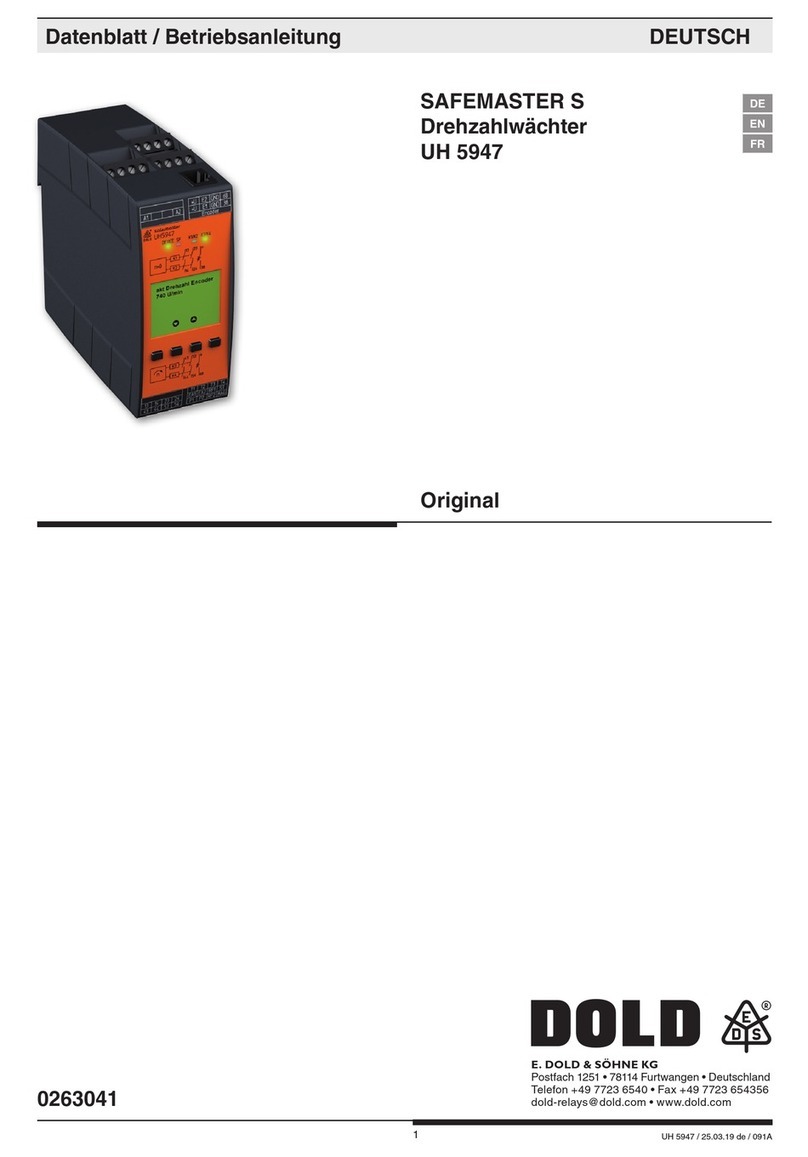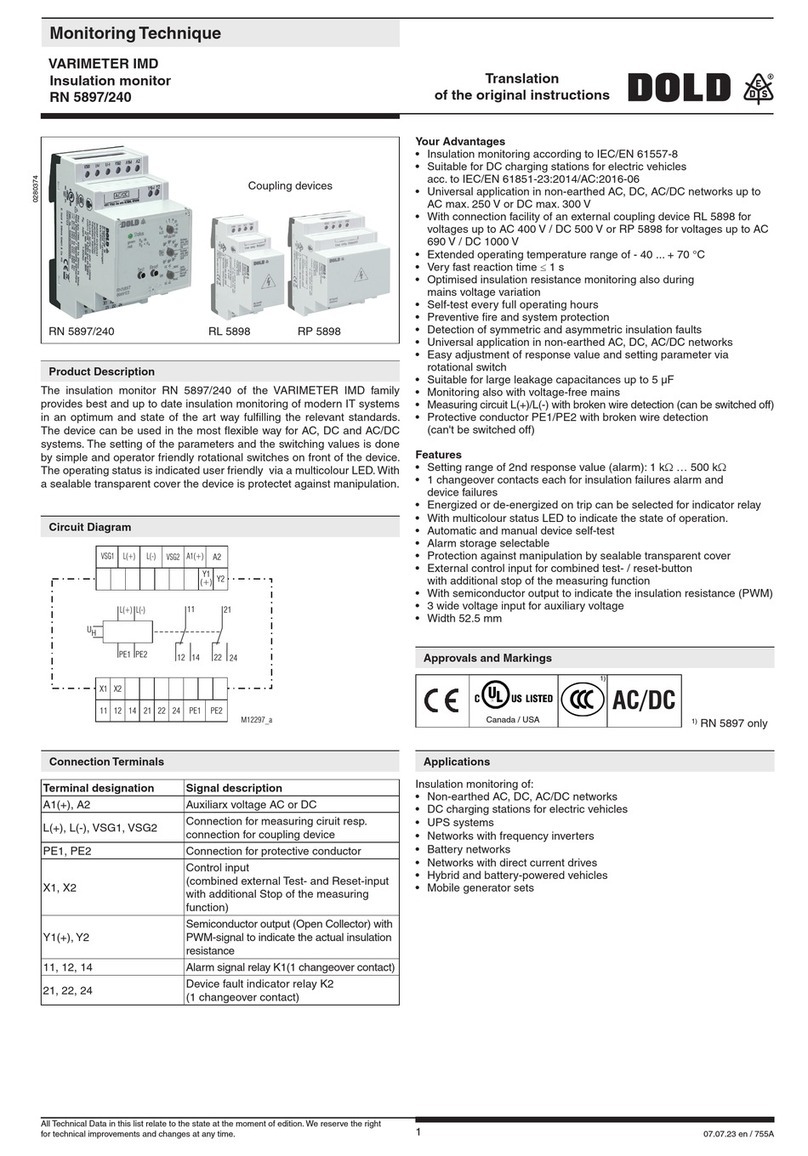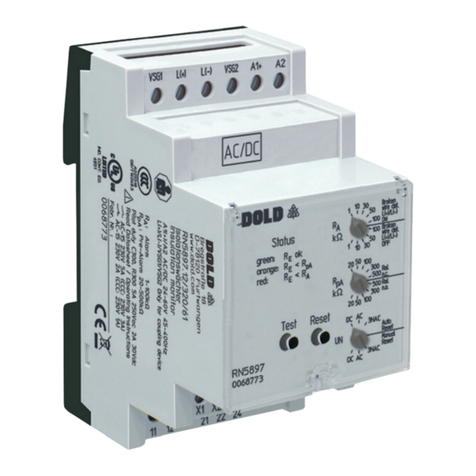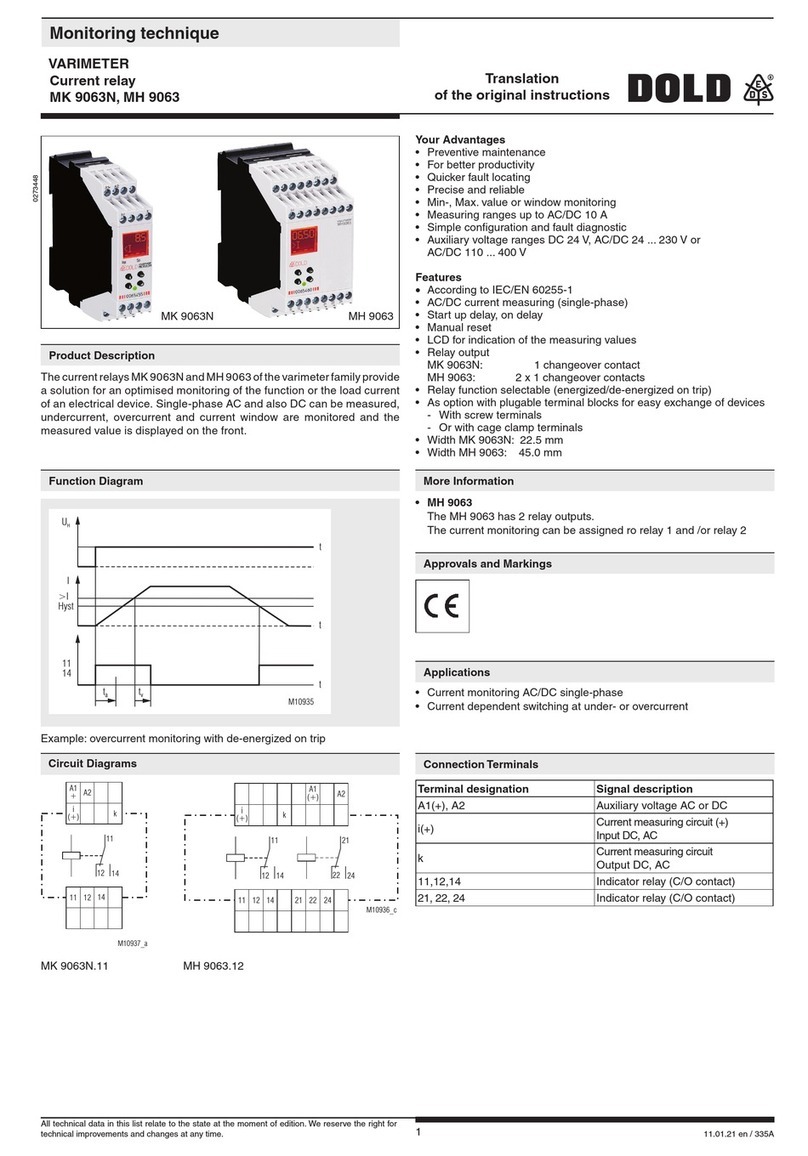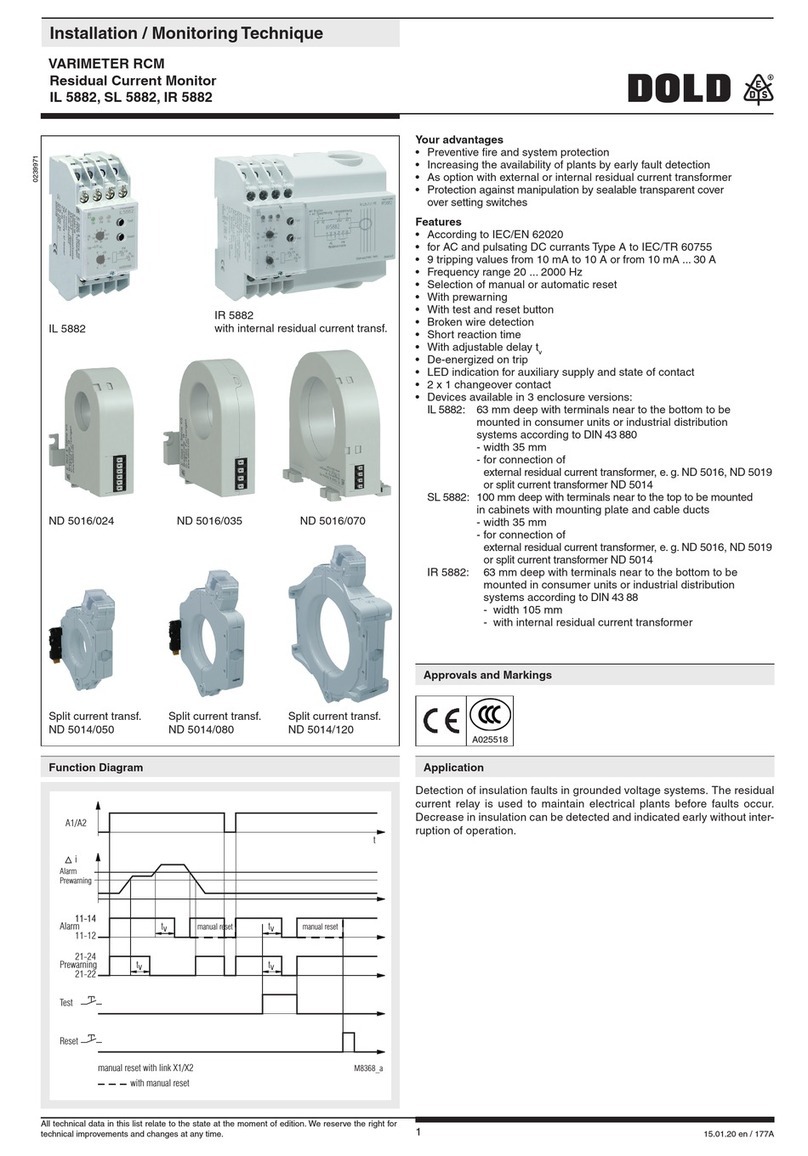
230.06.23 de / 752A
The device is supplied with DC auxiliary voltage via terminals A1(+) / A2.
Switching on the auxiliary voltage (Power-On) is followed by an internal
self-test for 12 sec (see „Device test functions“). The test process is visible
in the display. After this, measurement of the insulation resistance in the
measuring circuits begins and the the colour of the backlight changes
into green.
Measuring circuit
(Insulation measurement between terminals L(+) / L(-) and PE1/PE2)
The insulation monitor RN 5897/011 can be operated either with or without
coupling device. Max. mains voltage and connection diagrams have to
be observed!
If the insulation monitor is operated without coupling device the terminals
L(+) and L(-) have to be connected directly to the voltage system to be
monitored. and the terminals VSG1/L(+) and VSG2/L(-) each have to be
bridged (see also operation with coupling device).
A broken wire detection that can be disabled provides a fault signal if both
terminals L(+) and L(-) are not linked by the connected network.
The type of network (AC, DC, 3NAC) has to be selected.
Also the terminals PE1 and PE2 have to be connected with 2 separate
wires to the protective earth. An interruption of a wire also causes a fault
signal (see section ”Behavior on faulty connection”). The monitoring of
the PE connection cannot be de-activated.
To measure the insulation resistance an active measuring voltage with
changing polarity is connected between L(+)/L(-) and PE1/PE2.The
momentary polarity of the measuring cycle is shown on the display by 2
curser segments („MP+“ for positive phase and „MP-“ for negative phase).
The duration of the positive and negative measuring phase depends on
the setting of the max. leakage capacity („CE[µF]“ in programming mode),
the actual leakage capacity of the monitored system and in DC systems
also on the level and duration of possible voltage variations. This allows
a correct and fast measurement in different network conditions.
At the end of a measuring cycle the actual insulation resistance is produced
and indicated. The actual value is shown on the display. The relays for alarm
K1 and pre-alarm K2 switch when dropping under the adjusted response
values. In addition the backlight of the display changes to orange color
on pre-alarm or to red color on alarm. An asymmetric earth fault either to
„+“ or „-“ is also indicated on the display (only in DC- systems, or with a
fault on the DC-side of a system).
Manual reset of fault message
Using the display menu in programming mode or programming via Modbus,
the manual reset function for insulation failures can be selected. If manual
reset is activated the insulation fault signals of the measuring circuit are
stored when dropping under the adjusted response values also if the
insulation resistance goes back to healthy state. The minimum value is
stored and can be shown on the display and via Modbus. Pressing the
„Reset“ button on the front side for 2 s, the alarm signal and the stored
minimum value are reset if the actual insulation resistance is in healthy state.
The device can also be reset with a Modbus command.
Indicator relay for insulation fault signal
For the indicator relays K1 (contacts 11-12-14, for alarm) and K2 (contacts
21-22-24, for pre-alarm) the function can be set in programming mode
via display menu or Modbus to energized on trip or de-energized on trip
when the insulation resistance drops below the adjusted response value.
The status of the indicator relays is shown on the display with the two cursor
segments "K1" and "K2". When the relay is energized, the corresponding
curser lights up. The status of the indicator relays is also shown via Modbus.
Using the insulation fault locating system
via trigger output
There is an additional trigger output for an insulation fault detection system
on the insulation monitor RN 5897/011.
This trigger output (Y1-Y2) can be coupled with the trigger input Y1-Y2
of RR 5886 to initiate automatic fault location with the insulation fault
locating system, consisting of RR 5886 and RR 5887. The trigger output is
activated when the measuring value drops under the alarm response value
(RE< RA). As long as it stays under the response value or an alarm is
stored, the trigger output Y1-Y2 remains active.
Via Modbus
The locating current injector RR 5886 has also a Modbus RTU interface.
This allows the master PLC to control the insulation fault location system
via the same bus system according to the specifications of the RR 5886,
if the fault location is to be started after evaluation of the corresponding
registers of the insulation monitor.
Broken wire detection
As described in section "Measuring circut", the measuring circuits L(+)/L(-)
and the protective conductors PE1/PE2 are constantly monitored for wire
breaks – not only at Power-On or a manual or occasional automatic test.
The response time of monitoring is only a few seconds. Broken wire
detection between L(+) and L(-) is performed via coupled alternating
voltage. This alternating voltage is short-circuited if the terminals are
connected to the connected mains at low-resistance. The device detects
that the mains to be monitored is properly connected.
Since this broken wire detection is carried out with alternating voltage, large
capacitances should be avoided between L(+) and L(-), since the capacitive
reactance of these capacitances also short-circuits this alternating voltage.
The device would no longer detect a connection fault on L(+)/L(-).
Especially parallel lines should be prevented over larger distances.
If larger capacitances between L(+)/L(-) cannot be avoided or if the coupled
alternating voltage interferes with the system, the broken wire detection
can be de-activated using the display menu in programming mode or
programming via Modbus. Monitoring deactivated, monitoring only during
device test or continuous monitoring (every 2 minutes for 10 s) are the
possible options. If the broken wire detection on L(+)/L(-) is de-activated
no AC voltage is injected.
The broken wire detection on PE1/PE2 cannot be de-activated.
Device test functions
Principally, 2 different test functions are implemented: The "self-test" and
the "expanded test":
The self-test of the device is performed automatically after Power-On and
every full operating hours. It can also be triggered manually at any time by
pressing the "Test" button at the device front for 2 s or via Modbus command.
With the self-test, contrary to the expanded test, the status of the Indicator
relays is not affected; the sequence is as follows:
The display backlight colour changes into orange.For approx.. 2 s all pixels
and segments of the LCD are shown. After that the text “Test1” comes up
and the measuring pulse is switched for approx. 5 s to negative test phase.
Additionally the test mode is shown via Modbus. The polarity of the test
voltage is also indicated on the display by curser segments. Within these 5
s the internal measuring circuit is checked for failures. Then the measuring
pulse is switched for approx. 5 s to positive test phase and more internal
tests take place. If no failures turned up and had been recognized, the
measurement continuous. The extended test
procedure is started when during or at the end of the above described 12 s
self-test the test button is pressed again for 2 s or via a Modbus command.
The sequence is similar to the self-test (2 measuring phases of 5 s each) but
in addition the output relays go in alarm stated. The display shows “Test2”
and via the Modbus the extended test is indicated, too. The test phases of
the extended test will be repeated continuously. The extended test can be
finished after the first complete sequence (approx. 10 s) by pressing the
"reset" button for 2 seconds. The device starts the insulation monitoring
again. The extended test can be finished via a Modbus command, too.
Test signal
1)
Reset signal
2)
Relay state K1 and K2
Measuring voltage
Positive
Alarm
No Alarm
Insulation
measurement
Insulation
measurement
Insulation
measurement
3)
4)
Self test (Test 1)
Duration: approx. 12s
Self test (Test 1)
Duration: approx. 12s
Duration: approx. 10s
Continuous extended
test (Test 2)
Negative
M12462
U
t
1) Test signal: Button Test > 2 s or X1/X2 < 3 s
2) Reset signal: Button Reset > 2 s or X1/X2 > 3 s
3) To initiate the extended test (Test 2) the test signal must be operated
within the self test (Test 1) again.
4) The reset signal has here no function, as the first complete sequence
of extended test (Test 2) is not finished.
Function Function
